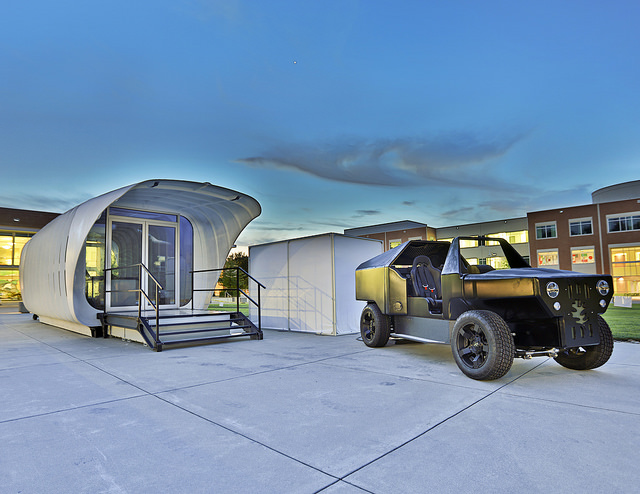AMIE Combines 3D Printing and Alternative Energy

The AMIE demonstration showcases the possibility for a greener tomorrow thanks to 3D printing and alternative energy. Courtesy of ORNL.
Latest News
October 15, 2015
During the first Democratic debate of 2015, we heard a fair amount about how the country needs to invest in innovative forms of green energy. While a greater investment would be welcome, innovation is already occurring at places like the Oak Ridge National Laboratory (ORNL). Researchers work daily at developing new technologies and strategies for the living spaces and industry of tomorrow.
AMIE (Additive Manufacturing Integrated Energy) is one of ORNL’s recent projects, which combines additive manufacturing (AM) with alternative energy to showcase new possibilities for a green future. It showcases the manner in which bidirectional energy can power both a small house and a personal vehicle.
 The AMIE demonstration showcases the possibility for a greener tomorrow thanks to 3D printing and alternative energy. Courtesy of ORNL.
The AMIE demonstration showcases the possibility for a greener tomorrow thanks to 3D printing and alternative energy. Courtesy of ORNL.The demonstration house, which is just large enough at 38x12x13 ft. to appeal to people eager to live in a cargo container, is generally powered by gathering solar energy from panels installed on its roof. Excess energy is stored in a battery located under the house.
The green vehicle designed to go along with the house is a hybrid that uses both electricity and natural gas. When not in use ferrying its owners around, the vehicle parks over a wireless induction pad. Unlike most induction pads, this one works in two directions. The car can draw energy from the house’s battery reserves when it’s low on juice, or the car can act like an additional energy source for the house by switching on and generating power.
“Working together, we designed a building that innovates construction and building practices and a vehicle with a long enough range to serve as a primary power source,” said ORNL’s Roderick Jackson, who led the AMIE demonstration project. “Our integrated system allows you to get multiple uses out of your vehicle.”
AM enters the picture in the construction and prototyping phases. Both the car and the house were built using ORNL’s Big Area Additive Manufacturing (BAAM) process, which has previously been put to use building a Shelby Cobra and is the same technology used to create the Strati. Think of BAAM as an oversized Fused Deposition Modeling system and you’re on the right track. The main difference between BAAM and other extrusion-based 3D printers is that layer thickness for BAAM is measured in inches, rather than micrometers.
The BAAM process is able to (relatively) quickly build large objects with far less waste than is produced with traditional manufacturing processes. It is accurate enough to following exacting digital designs, and the plastic parts produced by the system can be worked and machined following a build. Much excess waste can even be ground up and reused.
AMIE offers a glimpse into the possibilities of tomorrow, where 3D printed houses and cars work together to offer a greener future. The technologies being developed by ORNL will be used to, literally, shape our world. Below you’ll find a video about the AMIE project.
Source: ORNL
Subscribe to our FREE magazine, FREE email newsletters or both!
Latest News
About the Author
John NewmanJohn Newman is a Digital Engineering contributor who focuses on 3D printing. Contact him via [email protected] and read his posts on Rapid Ready Technology.
Follow DE





